(Ray Brandes traces a quarter-century collaboration by leading lights of the San Diego scene.)
1984-?
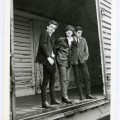 Steven Van Zandt, guitarist for the E Street Band and host of “Little Steven’s Underground Garage,” once called it “one of the most unspeakably gorgeous instances of romantic yearning disguised as a pop song.” Indeed, the Nashville Ramblers. song “The Trains” is a perfect piece of pop music: a once-in-a-lifetime convergence of thoughtful lyrics, exquisite melody and flawless performances by three of San Diego.s most celebrated musicians. The song, available on Rhino’s Children of Nuggets box set but until recently only found on an obscure late-’80s pop compilation album, would be by itself enough to secure the Nashville Ramblers a place in the pantheon of great 20th century recordings.
Steven Van Zandt, guitarist for the E Street Band and host of “Little Steven’s Underground Garage,” once called it “one of the most unspeakably gorgeous instances of romantic yearning disguised as a pop song.” Indeed, the Nashville Ramblers. song “The Trains” is a perfect piece of pop music: a once-in-a-lifetime convergence of thoughtful lyrics, exquisite melody and flawless performances by three of San Diego.s most celebrated musicians. The song, available on Rhino’s Children of Nuggets box set but until recently only found on an obscure late-’80s pop compilation album, would be by itself enough to secure the Nashville Ramblers a place in the pantheon of great 20th century recordings.
Carl Rusk’s timeless anthem, however, only offered the world a brief glimpse of the vast talents of this undiscovered San Diego treasure. They have remained, outside of a small group of devoted fans, unknown and unappreciated. But a devotion to preserving the music they love, as well as an anger and disdain for the era in which they live, have driven them for more than 25 years.
The concept of a “supergroup” originated in the late 1960s with groups like Crosby, Stills, Nash and Young and Emerson, Lake and Palmer and quickly left a bad taste in the mouths of critics everywhere. A 1974 Time magazine article dismissed the phenomenon as an “amalgam formed by the talented malcontents of other bands.” The Nashville Ramblers, while undoubtedly comprised of three of the most infamous musicians in San Diego sixties garage punk/rhythm ‘n’ blues, have always lacked the dueling egos, upstaging and musical infighting which often characterize such bands. Instead, the individual members of the band are lifelong friends who have formed the perfect musical as well as personal complement to each other.
All Good Things
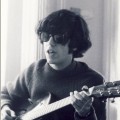 Carl Rusk first began acting, then writing and performing professionally at the age of 12. His earliest musical projects were the Cavity Creeps, formed with Mark Zadarnowski of the Crawdaddys and his then-girlfriend Lydia Butinski; the Bogtrotters, with Joe Piper, Mark Zadarnowski and John Stoup; the Ideals, with Ray Brandes, Maure Silverman, Tony Paulerio and Paul Carsola; and the Hedgehogs, with Ray Brandes, Ron Silva and Paul Carsola. Carl had a natural musical inclination from an early age and applied himself with an intense dedication to becoming first an accomplished guitarist and later a singer and songwriter.
Carl Rusk first began acting, then writing and performing professionally at the age of 12. His earliest musical projects were the Cavity Creeps, formed with Mark Zadarnowski of the Crawdaddys and his then-girlfriend Lydia Butinski; the Bogtrotters, with Joe Piper, Mark Zadarnowski and John Stoup; the Ideals, with Ray Brandes, Maure Silverman, Tony Paulerio and Paul Carsola; and the Hedgehogs, with Ray Brandes, Ron Silva and Paul Carsola. Carl had a natural musical inclination from an early age and applied himself with an intense dedication to becoming first an accomplished guitarist and later a singer and songwriter.
Carl’s pre-Ramblers career hit a peak with the short-lived Mystery Machine, a band formed in the summer of 1983 that played a total of three shows: one in San Diego, one in Los Angeles and one in Orange County. The band was primarily a vehicle for Carl’s emerging songwriting talents, which found their place alongside folk-rock covers by the Byrds, Love, the Dovers and the Cryin’ Shames. “She’s Not Mine,”which appears on the second volume of Bomp’s “Battle of the Garage Bands,” was the only official release of the Mystery Machine. The group disbanded at the end of the summer when Carl moved to San Francisco to attend the San Francisco Art Academy.
The Crawdaddys, who were in the process of drawing their last breaths, arrived in the Bay area in early 1984 to record the tracks that would later comprise their “Here ‘Tis”album at Josef Marc’s studio in Berkeley, Calif. Carl skipped school to participate in each of the recording sessions. Former Hedgehog and Crawdaddy vocalist Ron Silva suggested Carl move back to San Diego to form a new group based in moody, folk-influenced pop.
 Silva’s allegiance to early-’60s beat and pop music is legendary. His name has become synonymous with the ’60s revival he spearheaded in the late 1970s in San Diego, and he is respected worldwide as a singer and musician. His fidelity to detail, in total look and sound, had a big influence upon Carl’s own vision. Rusk’s relationship with Silva had begun on August 10, 1979, when the two met backstage at a Crawdaddys show at the Backdoor at San Diego State University. A growing friendship and mutual respect developed further as the Hedgehogs played countless gigs throughout 1981 and 1982. The two became constant companions, Ron staying at Carl’s parents’ house, and Carl joining Ron for several extracurricular Crawdaddys musical projects.
Silva’s allegiance to early-’60s beat and pop music is legendary. His name has become synonymous with the ’60s revival he spearheaded in the late 1970s in San Diego, and he is respected worldwide as a singer and musician. His fidelity to detail, in total look and sound, had a big influence upon Carl’s own vision. Rusk’s relationship with Silva had begun on August 10, 1979, when the two met backstage at a Crawdaddys show at the Backdoor at San Diego State University. A growing friendship and mutual respect developed further as the Hedgehogs played countless gigs throughout 1981 and 1982. The two became constant companions, Ron staying at Carl’s parents’ house, and Carl joining Ron for several extracurricular Crawdaddys musical projects.
Ron’s offer was the exactly the opportunity Rusk, who had grown a bit disconsolate on his own in San Francisco, was looking for. He missed playing music and was spending much of his time holed up in his apartment in the Haight, where he immersed himself in Bob Dylan and wrote the songs “The Trains” and “No Other Girl.” Weekend visits to San Diego to record with the Mystery Machine and open for the Tell-Tale Hearts at Greenwich Village West did little to quench his desire to return to regular performing. “I knew I was kidding myself going to art school, and left San Franciso as soon as the school year ended,” he says.
That’s When Happiness Began
Upon returning to San Diego, Rusk joined Silva for a final couple of shows billed as the Crawdaddys, and began looking for other players to round out what would eventually become the Nashville Ramblers. It was decided that while they both were both multi-talented instrumentalists, Carl would play guitar and Ron would play drums. They experimented with second guitarists and bass players but were unable to find the perfect combination. “Eventually, Ron and I realized that our vision was just too specific to include anyone else,” recalls Rusk.
By this time, Rusk had amassed an impressive catalog of songs, drawing from his strongest influences: Paul Simon, Pete Townshend and the New York Brill Building composers like Gerry Goffin and Carol King, Ellie Greenwich, and Jeff Barry. Ron and Carl were living in the converted bar of the Maryland Retirement Hotel in Downtown San Diego on 6th Avenue and F Street. Walking home from El Indio’s one afternoon, the two were inspired to call their band “The Nash Ramblers.” According to Carl, “The mix of the word ‘Nash’ and the obvious car reference seemed perfect for our American/British style. Over time people began saying ‘Nashville’ instead of Nash on their own, and we just went with it. It was fine with us because it reminded us of the Nashville Teens.” The name also recalled Manchester’s “The Country Gentlemen,” whose name winked at a model of Gretsch guitars, and whose single “Baby Jean” predated the Rambler sound by 20 years.
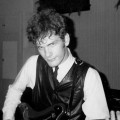 The final piece of the puzzle was not at first an obvious choice. Tom Ward had already firmly established himself as a formidable bass player, first by joining the Gravedigger V in 1984 to give the group some much-needed musical credibility, and later through playing stints with Manual Scan and the Wickershams. Tom was a mere 17 years old, younger even than 18-year-old Carl, who was still considered a prodigy by many. But aside from his immaculate playing, Tom brought to the group a completeness that was both unexpected and welcomed by Ron and Carl. “Tom was eager, affable, and happy enough to be a part of what we doing to adapt himself to our vision,” Carl explains. “But perhaps more importantly, he shared our intense feeling of isolation from all other people — an inability to feel a part of any group, movement, religion or even family. This feeling of isolation is the glue that holds the Ramblers together. That and the sheer enjoyment of playing together.”
The final piece of the puzzle was not at first an obvious choice. Tom Ward had already firmly established himself as a formidable bass player, first by joining the Gravedigger V in 1984 to give the group some much-needed musical credibility, and later through playing stints with Manual Scan and the Wickershams. Tom was a mere 17 years old, younger even than 18-year-old Carl, who was still considered a prodigy by many. But aside from his immaculate playing, Tom brought to the group a completeness that was both unexpected and welcomed by Ron and Carl. “Tom was eager, affable, and happy enough to be a part of what we doing to adapt himself to our vision,” Carl explains. “But perhaps more importantly, he shared our intense feeling of isolation from all other people — an inability to feel a part of any group, movement, religion or even family. This feeling of isolation is the glue that holds the Ramblers together. That and the sheer enjoyment of playing together.”
Tom recalls that “Carl and Ron were looking to form a band out of their longtime, pre-existing association with each other, and after a trying out one or two other people, they settled on me for the bass “chair” — never quite finding a fourth — so the band became, and remained, a trio. I was glad to get into a group with these musically authoritative figures, who were also colorful characters with effortlessly distinctive personalities.”
Ward delighted in the opportunity to share the stage with such interesting and intriguing musicians. Silva, a world-class drummer, helped him become an even better bassist. “Ron could astound me with some crazy tom-tom fills and rolls, and he could sing at the same time. I learned my sense of time from him, so we are always together, as when there is a complete break or full stop in the midst of a tune,” Tom explains. “When we come back in, I know it’s going to be right, because he is confidently masterful on “the tubs” as he used to jokingly refer to them — and at age 17 it was my job to figure out where he was going to be, and I learned to match the subtlety of his musical time instinct.”
It was also, however, Rusk’s unyielding and resolute musical integrity that attracted Tom to the group. “Carl is a perfectionist who wrote a song called ‘I Can’t Compromise,’ but chose not to publish it, possibly because he felt it wasn’t good enough as it stood and would thus be a compromise,” says Tom. “His shining star — the music itself, as he selects it — remains a source of wonder and an inspiration to him, and, by proximity, to those who know him and work with him in realizing at least a part of his vision and intent.”
Fight Fire
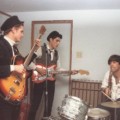 Carl’s conception of the band was drawn from his love of two inspirations: British beat music and American folk-rock. These two powerful influences, along with an inclination toward both the melodic and the melancholy, would infuse not only all of Rusk’s original material, but the songs the band would cover. Their playing was compact, relying on clever breaks, punchy drums and crisp arrangements. The group’s approach to their music seemed almost hostile, however: a blistering, aggressive guitar attack; an onslaught of drums and cymbals, and forceful two and three part harmonies. If the analogy seems overly militaristic, the band members often saw themselves in a battle to win the hearts and minds of every audience to whom they played. Tom explains: “Perhaps we recognized the ‘modern world’ as a ‘tank war,’ if you’ll pardon the metaphor, but were determined to deploy those cavalry tactics. It seemed like its own kind of glory in those heavy-metal and blitzkrieg-bop years: to have some chops, but to utilize a bit less firepower, and not to bludgeon the audience. We brought small amps to bear and maintained formation.”
Carl’s conception of the band was drawn from his love of two inspirations: British beat music and American folk-rock. These two powerful influences, along with an inclination toward both the melodic and the melancholy, would infuse not only all of Rusk’s original material, but the songs the band would cover. Their playing was compact, relying on clever breaks, punchy drums and crisp arrangements. The group’s approach to their music seemed almost hostile, however: a blistering, aggressive guitar attack; an onslaught of drums and cymbals, and forceful two and three part harmonies. If the analogy seems overly militaristic, the band members often saw themselves in a battle to win the hearts and minds of every audience to whom they played. Tom explains: “Perhaps we recognized the ‘modern world’ as a ‘tank war,’ if you’ll pardon the metaphor, but were determined to deploy those cavalry tactics. It seemed like its own kind of glory in those heavy-metal and blitzkrieg-bop years: to have some chops, but to utilize a bit less firepower, and not to bludgeon the audience. We brought small amps to bear and maintained formation.”
From the outset, the group was unified in their total onstage anachronism. They were determined to be a band that could compete, not with their contemporaries — most of whom lacked a coherent, uncompromising vision — but rather with ’60s groups like the Remains and the virtually unknown Dovers and Just Four Men. According to Carl, “We shared a love for a specific spooky yet aggressive melodic sound. I remember being very surprised the first time we heard The Everly Brothers’ Two Yanks in England album, an unapologetically American take on British pop. This was really very close to the sound that we had developed on our own. In addition we were heavily inspired by other American garage bands with similar tastes— The Remains, Kenny and The Casuals, The Rising Storm, and The Rockin’ Ramrods.”
The Ramblers first began rehearsing at Paradiddles on 30th Street in North Park, then received a parental green light to practice in a finished shed behind Tom’s family’s home in Serra Mesa. They played early shows at the ZLAC Rowing Club in Pacific Beach, the New Sounds festival at the New Generation Nightclub and Greg Shaw’s Cavern Club in Hollywood. On one memorable evening there, while the band was playing the Merseybeats’ arrangement of “Zip-a-dee-do-dah,” Sky Saxon of the Seeds was moved to rush the stage and sing with the band. Carl refused to surrender the microphone.
This incident, perhaps more than any other, crystalizes the difference between the Ramblers and many of the other ’60s-influenced bands who made their home at the Cavern at in 1984 and 1985. Any number of them would have welcomed the Seeds’ mythical singer to the stage, and most would have certainly allowed him to overstay his welcome by several songs. The Ramblers, however, were steadfast, perhaps even obstinate, in their musical principles. Their refusal to compromise, combined with their narrow and specific vision, often left them without an audience sophisticated enough to appreciate them. They would revel in this non-conformity, playing George Jones songs when paired with a mod band and more psychedelic numbers when opening a roots or rockabilly show.
Recording “The Trains”
Soon after their inception, the Ramblers wasted no time in getting into a recording studio. Carl had known the Unknowns’ Mark Neill since early 1980, and in 1985 Mark began mentoring Carl’s interest in record engineering. “I had bought one of Bill Putnam’s Universal Audio consoles from him — the one that the Doors had acquired from UA for their “Doors Workshop” studio,” says Carl. “It still had the phase/pan knob that Bruce Botnick had installed specifically for the guitar effect in ‘Hello, I Love You.’ ”
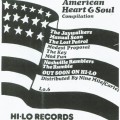 The day after playing their first Los Angeles show Cavern Club in the summer of 1985, the band arrived at Mark Neill’s recording studio in Dulzura, Calif. Greg Shaw had asked them to record something for inclusion on a Hi-Lo Records British release, “American Heart and Soul,” which would also include a song by San Diego’s Manual Scan. The Ramblers recorded two Rusk originals, “The Trains” and “Nashville Ramblin’ ” and a cover of the Golliwogs (the Fogerty brothers’ pre-Creedence Clearwater Revival band) called “Fragile Child.” “Since then, we have never recorded with anyone else, other than what we have recorded on our own — which is precious little,” says Rusk.
The day after playing their first Los Angeles show Cavern Club in the summer of 1985, the band arrived at Mark Neill’s recording studio in Dulzura, Calif. Greg Shaw had asked them to record something for inclusion on a Hi-Lo Records British release, “American Heart and Soul,” which would also include a song by San Diego’s Manual Scan. The Ramblers recorded two Rusk originals, “The Trains” and “Nashville Ramblin’ ” and a cover of the Golliwogs (the Fogerty brothers’ pre-Creedence Clearwater Revival band) called “Fragile Child.” “Since then, we have never recorded with anyone else, other than what we have recorded on our own — which is precious little,” says Rusk.
The Nashville Ramblers play “The Trains.” Listen now!
Neil also had a strong influence upon Ward as a bass player. Tom explains: “Mark challenged me to play with a pick, a plectrum — which is what you hear on the LA records, and Scott Walker records, and Bert Kaempfert records — that percussive edge or ‘click.’ In the wake of that, I learned to play with a plectrum as well as finger-style. This went a long way toward my being more versatile and becoming more like the experienced session players heard in the past. Both techniques have their merits, and their appropriate application, but not all bass players can make use of both approaches with equal facility. I was lucky to be prodded toward the style I didn’t know yet by a shrewd and canny producer and aesthete like Mark, a great guitar and bass player as well as audio engineer.”
New York City and the Black Diamonds
True to their name, the Ramblers had a difficult time staying in one place for long. The continual movement of each of the band members reflected a restlessness — not with each other, however, but with the fickle music scenes and inadequate recording facilities available wherever they have landed. The band played together for a little over a year in San Diego but broke up for the first time when Carl moved to New York City. Ron joined him in Brooklyn and the two attempted for a time to work with the bass player for the Vipers, a band that had gained a considerable reputation in the mid-’80s garage-rock scene in New York. Meanwhile, Tom helped found the Town Criers with some of the former members of the Tell-Tale Hearts.
Ron brought his persuasive charm to bear in letters to Tom in San Diego throughout 1987. Soon enough, the Ramblers’ bassist packed a bass drum case full of clothes and moved to New York, where the band played a dozen shows and loft parties until the return to San Diego of Ron and Carl at the end of the summer.
Carl reflects on the New York period of the band: “In the summer of 1986, I decided it was time for a change and moved to New York. Several months later I convinced Ron and Tom to move as well. Ron was never happy with the Ramblers name, and while in New York, we played under several different names, eventually settling on The Black Diamonds, despite covering ‘See The Way’ by the Australian group of the same name.”
“Having had a break or two in our chronological and geographical history,” explains Tom, “it was easy to contemplate a name change. I floated a few, but none of them succeeded in capturing the others’ imaginations. But at some point, Carl had the notion of the Black Diamonds. I liked to think of it as a shape, like a design motif. In the old days it was a nickname for coal — it is the title of an obscure German novel from the 1890s, about some intrigues at a coal mine — but I think it was just a sound and rhythm and a sort of general evocation that lent an appeal to the name. So it was in our New York spring or summer, in 1988, that we became ‘The Black Diamonds.’ We went from being an abstract type of person in an exotic place — a ‘Rambler’ in a Nashville-of-the-mind — to becoming a shape and color which sounded kind of hard and gleaming, still located somewhere in the mind, a little less figurative and a little more abstract.”
In 1988, the band regrouped for in San Diego for another stay, recording again with Mark Neill, this time in his El Cajon studio. According to Carl, “We recorded three of my originals, ‘No Other Girl’ (written while in San Francisco and first played with The Mystery Machine); ‘Don’t Say You Love Me’; and ‘Late September.’ ” To date these recordings remain unreleased.
It was during this period that the Black Diamonds backed Jeff “Mono Man” Conolly, effectively becoming a West Coast version of the Lyres. Connolly had brought the group to California, and following a show at the Che Café decided to relocate. “We briefly backed up Jeff (Mono Man) Conolly as the Lyres,” says Carl, “for the sole reason that Ron wanted to make some money.” By all accounts, the experience was a disaster. Conolly had major disagreements with the group over equipment, tone and technique. Ultimately, Jeff moved back to Boston to reform the original group when all three members of the Black Diamonds quit simultaneously!
Ever restive, Carl returned to San Francisco on the last day of 1988, where he continued to write songs and record them himself. Tom and Ron again joined him later the next year, and the three traveled to Valdosta, Georgia to record with the newly relocated Mark Neil. Two songs, Carl’s Zombies-inspired “You Breathe and You Dream” and “Everyone,” were included on Rusk’s Blue Period album, which was finally released in 2000 by John McKinney’s Beathaven Records. Blue Period, a brilliant collection of songs that recall of the best of Big Star, Nick Drake and the Beach Boys, is sadly, the nearest thing to a Nashville Ramblers/Black Diamonds record available.
The Return of the Ramblers
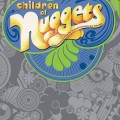 In 2005, Rhino Records released Children of Nuggets, which included “The Trains.” The Black Diamonds returned to their original name partly in response to the critical acclaim they have since received. In the past several years, “The Trains” has taken on a life of its own. “‘The Trains’ is like my grown up child from another marriage,” says Carl. “I see it now and again, and I amazed at the life it has been living without me. I do wish it would send some money home for once!”
In 2005, Rhino Records released Children of Nuggets, which included “The Trains.” The Black Diamonds returned to their original name partly in response to the critical acclaim they have since received. In the past several years, “The Trains” has taken on a life of its own. “‘The Trains’ is like my grown up child from another marriage,” says Carl. “I see it now and again, and I amazed at the life it has been living without me. I do wish it would send some money home for once!”
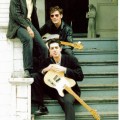 Ron has lived on and off in the Bay area and in San Diego for the past couple of decades, where he has recently revived his ’90s rhythm and blues review, Ron Silva and the Monarchs. After 10 years in New York City pursuing other musical projects, including becoming an accomplished singer/songwriter, Tom has since moved back to San Diego. Carl currently makes his home in upstate New York, and the Ramblers continue to play together about twice a year. “The only time I ever really feel entirely happy and whole is when I am playing music with Ron and Tom. That’s pretty much all there is to it,” says Carl. The group is currently working with Mark Neill to compile a recorded history of the Nashville Ramblers, which will include more than 25 years of unreleased recordings.
Ron has lived on and off in the Bay area and in San Diego for the past couple of decades, where he has recently revived his ’90s rhythm and blues review, Ron Silva and the Monarchs. After 10 years in New York City pursuing other musical projects, including becoming an accomplished singer/songwriter, Tom has since moved back to San Diego. Carl currently makes his home in upstate New York, and the Ramblers continue to play together about twice a year. “The only time I ever really feel entirely happy and whole is when I am playing music with Ron and Tom. That’s pretty much all there is to it,” says Carl. The group is currently working with Mark Neill to compile a recorded history of the Nashville Ramblers, which will include more than 25 years of unreleased recordings.
The Nashville Ramblers play “The Trains” on Audrey Moorehead and Domenic Priore’s “It’s Happening” cable television show in 1987:
The Nashville Ramblers Discography
“The Trains,” “Nashville Ramblin.” “American Heart and Soul Compilation. Hi-Lo Records, 1987.
“The Trains.” The Roots of Power Pop, Bomp Records, 1996.
“The Trains.” Children Of Nuggets: Original Artyfacts From The Second Psychedelic Era 1976-1996 (Box + 4xCD, Comp, RM) Rhino Records, 2005.
— Ray Brandes
Saw the Ramblers 2 shows in the greater Bay Area this past weekend…they were great!!!! They basically sound like walking into the Cavern Club and Listening to an early Beatles show with a slight injection of Billy Childish…..they are great!!!!